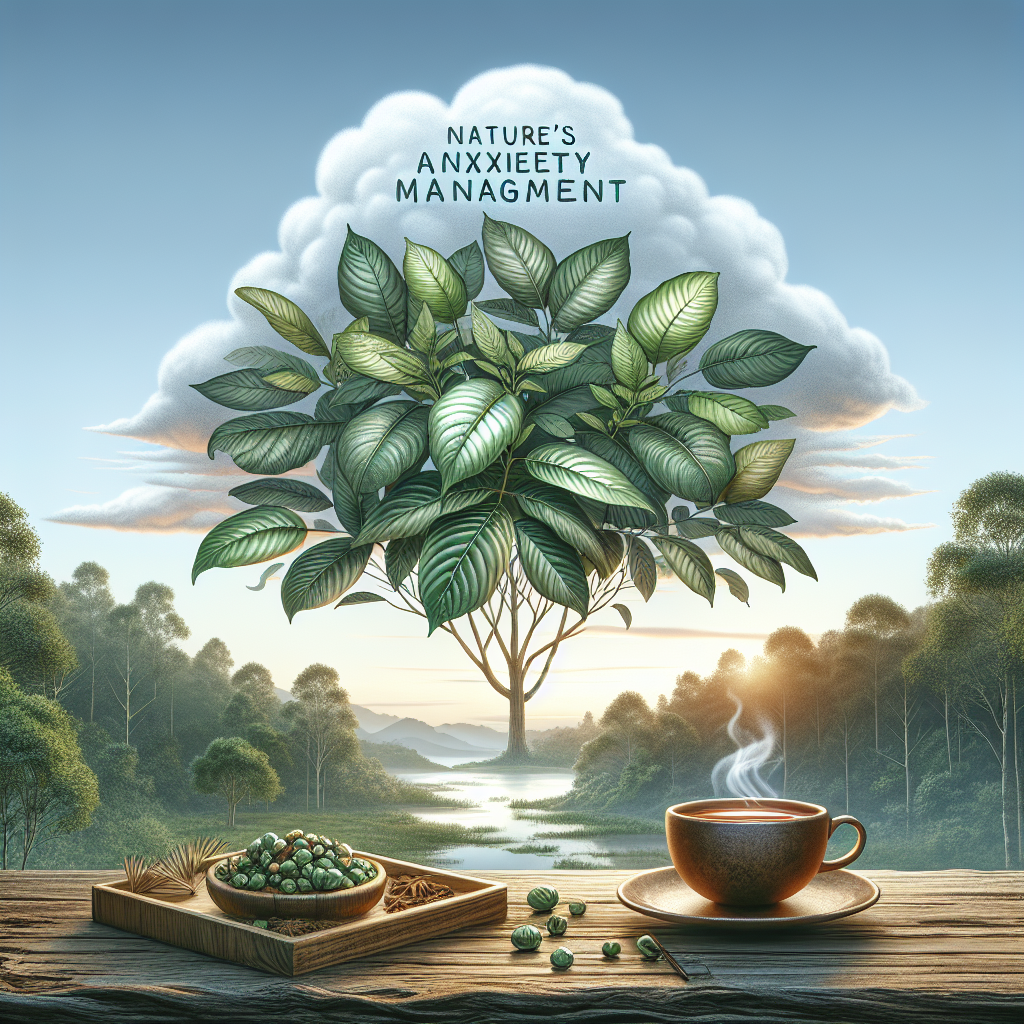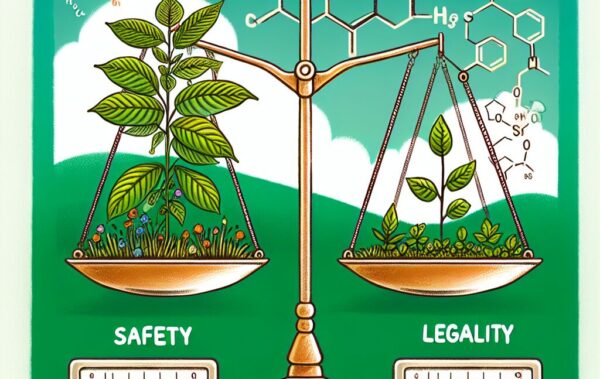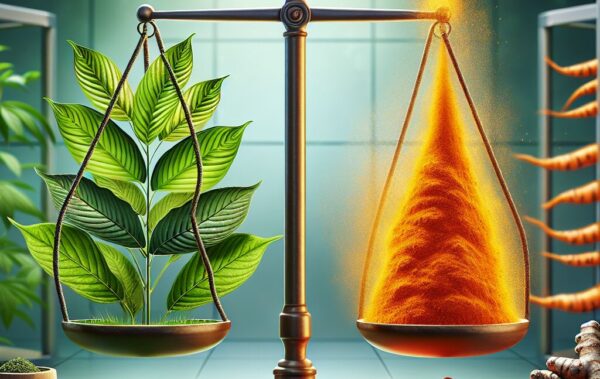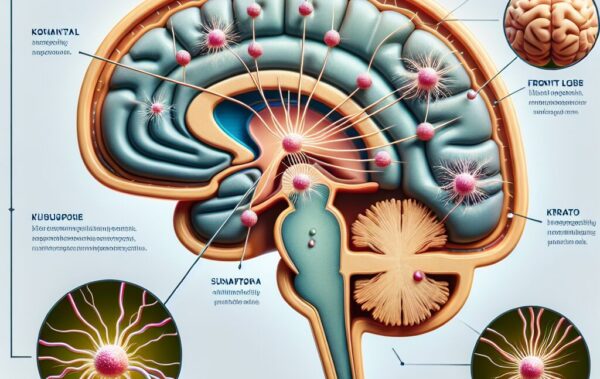- Understanding Kratom and Its Origins
- The science behind Kratom’s anxiolytic effects
- Methods of consumption and dosing for anxiety relief
- Comparative analysis: Kratom versus traditional anxiety medications
- Frequently asked questions about Kratom for anxiety management
Kratom, or Mitragyna speciosa, is a tropical evergreen tree in the coffee family native to Southeast Asia. Its origins can be traced back to Thailand, Indonesia, Malaysia, Myanmar, and Papua New Guinea, where it has been used for centuries as a traditional medicine. In these regions, the leaves of the kratom tree are valued for their varied therapeutic properties, including pain relief, energy enhancement, and importantly for our topic—natural anxiety relief.
Indigenous populations have traditionally chewed the leaves or brewed them into a tea, which they would then consume for various ailments. It wasn’t until more recent times that kratom emerged on the global stage as a natural alternative in the realm of herbal treatments for health issues like chronic pain, lethargy, opiate withdrawal—and of course, anxiety and stress reduction.
One of kratom’s appeals lies in its complexity. The leaves contain multiple active compounds called alkaloids, with mitragynine and 7-hydroxymitragynine being the most prominent. These alkaloids are believed to interact with the body’s opioid receptors, but not in the way that traditional opioids do. Instead, kratom exerts a more nuanced effect that can range from stimulant-like at lower doses to sedative at higher ones, which is where its potential for managing anxiety comes into play. This unique action profile of kratom’s active compounds may offer users a way to alleviate their anxiety without the typical side effects associated with conventional anxiety medications.
Exploring the world of kratom can be exciting, but it’s also essential for individuals to know about its various strains. These include varieties such as Maeng Da, Bali, and Malaysian, each offering a different balance of effects due to the variation in alkaloid content. Some strains are more energizing while others are more sedating; the strain best suited for addressing anxiety would typically lean toward the latter.
As kratom’s popularity grows, so do the methods of consumption. In the past, the traditional method of chewing leaves was the primary way of taking kratom. Nowadays, it can be found in several convenient forms, including powders, capsules, tea bags, and extracts. This variety allows users to choose the best method for their needs and lifestyle when seeking herbal treatments for their ailments.
As its presence has expanded, so has the scientific community’s interest in studying kratom. Several studies are starting to uncover the mechanisms behind kratom’s effects on mood and anxiety. The research is still emerging, but the anecdotal experiences of many who turn to kratom for natural anxiety relief continue to drive its popularity as a kratom alternative to traditional pharmaceutical options for anxiety management.
From its ancient roots in Southeast Asia to its current rise in popularity as a natural remedy, kratom has a storied past and a promising potential as an herbal treatment for anxiety. As with any natural substance, though, it should be approached with caution and respect, considering factors like individual health conditions, potential interactions with other medications, and the importance of using quality, responsibly-sourced products. Those new to kratom can find more information and a variety of products by exploring kratom markets online.
The science behind Kratom’s anxiolytic effects
Mitragynine, the prominent alkaloid in kratom, as well as its counterpart 7-hydroxymitragynine, are responsible for the plant’s anxiolytic, or anxiety-reducing, effects. Unlike typical anxiolytic drugs such as benzodiazepines, which bind directly to the GABAa receptors in the brain, kratom alkaloids seem to have a different mechanism of action. These compounds primarily affect the mu and delta opioid receptors, but not exclusively as an agonist like classical opiates. This nuanced interaction might explain why kratom can offer natural anxiety relief without leading to the significant dependency risks typically associated with opioids.
Research has documented the biphasic nature of kratom’s effects—meaning it has different outcomes depending on the dosage consumed. At lower doses, kratom may provide a stimulating effect that can help alleviate the fatigue often associated with depression and anxiety disorders. Conversely, higher doses are more likely to have a sedative effect, contributing to its stress reduction capabilities. This seems particularly beneficial for users who suffer from anxiety with associated symptoms such as insomnia, restlessness, or muscle tension.
Kratom’s ability to induce relaxation without overly sedating the user makes it a favorable herbal treatment for those who wish to manage their anxiety while maintaining daily functionality. The presence of other alkaloids and compounds within the leaves may also contribute synergistically to its anxiolytic effects, a phenomenon referred to as the entourage effect.
Scientific interest in kratom has spurred the investigation into its pharmacology, with studies hinting at its serotonin and norepinephrine reuptake inhibition properties. This is a similar action to that of certain antidepressants, which may explain the mood-boosting and anti-anxiety qualities observed by many kratom users. Additionally, its interaction with adrenergic receptors might lend to its energizing effects at smaller doses.
As research continues to delve into kratom’s potential as a kratom alternative for anxiety and stress, those interested in trying it for their own anxiety management can consider various strains and consumption methods. The sedating Red Vein Kratom, available in both powder and capsule forms, is often suggested for its potent relaxing properties. White Vein and Green Vein varieties may offer a balance between energy and stress reduction, depending on individual response.
It is crucial for potential users to remember that the FDA does not regulate kratom for anxiety management, and thus, dosage recommendations and efficacy can vary. Proper research, consultation with healthcare providers, and obtaining kratom from reputable sources are vital steps before incorporating this or any herbal treatment into a wellness routine.
Methods of consumption and dosing for anxiety relief
When considering kratom for natural anxiety relief, understanding the various methods of consumption, and how dosing can affect one’s experience, is essential. The traditional use of kratom, which involves chewing the leaves or brewing them into a tea, is still practiced today. Nonetheless, with kratom’s integration into modern wellness practices, users have an array of ingestion methods to choose from, each with its individual onset and duration of effects.
For those seeking a straightforward approach, kratom capsules are a discreet and convenient option. Capsules allow for precise dosing, eliminating the variability and taste that comes with powdered leaves. For instance, Red Vein kratom capsules are a popular choice for their calming properties and can be found in various dosages to suit an individual’s needs.
Kratom powder, on the other hand, offers versatility in consumption. It can be mixed into beverages, such as smoothies or juices, or brewed into a tea for those who appreciate the ritual of preparing their herbal treatment. The powder also allows individuals to adjust their dosage more freely, tailoring their intake to the desired level of stress reduction. It is worth noting that kratom powder tends to have a quicker onset when taken on an empty stomach.
For those who enjoy warm beverages, kratom tea bags provide a comforting method of ingestion. A cup of kratom tea in the evenings can be particularly soothing for those dealing with stress-related insomnia or muscle tension. Additionally, the act of sipping tea can be a meditative practice in itself, contributing further to stress relief.
Kratom extract products, whether it’s in the form of tinctures, shots, or liquid extracts, provide a more potent experience and are generally recommended for users already familiar with kratom’s effects. As extracts can be significantly stronger than other forms, starting with a lower dose is advisable to gauge individual sensitivity.
Determining the most suitable dosage for anxiety relief is a subjective process that requires careful consideration. New users are encouraged to start with smaller amounts to observe how their body responds. A lower dose can result in stimulating effects, which might alleviate anxiety for those who find relief in enhanced alertness and energy. Conversely, higher doses are known for their more sedative properties, which may benefit those whose anxiety manifests in physical agitation or racing thoughts.
It is essential to remember that kratom is not one-size-fits-all when it comes to dosing. Factors such as body weight, individual metabolism, tolerance levels, and the specific strain of kratom all play a role in finding the optimal dose for anxiety management. As with any herbal treatment, moderation is key, and it’s critical to listen to one’s body and adjust accordingly.
Given the variability in potency and personal reaction to kratom, keeping a document or journal of one’s experiences can be helpful when determining the most effective method and dosage for anxiety relief. Furthermore, users should obtain kratom from credible sources to ensure product quality and consistency.
It cannot be overstated that anyone interested in using kratom for herbal treatment should proceed with caution. Consulting a healthcare professional prior to beginning any new supplement regimen is always a sensible precaution, particularly for individuals with preexisting conditions or who are currently taking other medications.
| Method of Consumption | Typical Onset Time | Duration of Effects | Notes |
|---|---|---|---|
| Capsules | 30-45 minutes | 4-6 hours | Precise dosing, convenient |
| Powder | 15-30 minutes | 3-5 hours | Versatile, dosage flexibility |
| Tea Bags | 20-40 minutes | 4-6 hours | Comforting, ritualistic |
| Extracts/Tinctures | 5-20 minutes | 3-4 hours | Potent, experienced users |
As we consider all of these factors, the significance of kratom’s versatility as a natural alternative to pharmaceutical anxiety medications becomes apparent. The capability to choose and fine-tune one’s consumption method and dose allows for a personalized and empowering approach to managing anxiety. This adaptability, coupled with the anecdotal and emerging scientific support for kratom’s anxiolytic effects, positions it as a potentially valuable herbal treatment within the realm of stress reduction and mental health wellness.
In conclusion, while kratom may provide an alternative path to those seeking herbal treatments for anxiety, it is critical to approach its use thoughtfully, armed with accurate information, and in consultation with healthcare professionals. The natural appeal of kratom signifies not just an ancient remedy but a contemporary beacon for those inclined towards nature’s bounty in their quest for mental clarity and peace.
Comparative analysis: Kratom versus traditional anxiety medications
 When we set the stage for a comparative analysis between kratom and traditional anxiety medications, we delve into a discussion that involves both pros and cons, effectiveness, side-effect profiles, and individual suitability. Traditional anxiety medications, such as benzodiazepines and selective serotonin reuptake inhibitors (SSRIs), have been the cornerstone of treating anxiety disorders for decades. However, concerns over side effects, dependency, and the desire for a more natural approach have steered some individuals towards exploring kratom alternatives.
When we set the stage for a comparative analysis between kratom and traditional anxiety medications, we delve into a discussion that involves both pros and cons, effectiveness, side-effect profiles, and individual suitability. Traditional anxiety medications, such as benzodiazepines and selective serotonin reuptake inhibitors (SSRIs), have been the cornerstone of treating anxiety disorders for decades. However, concerns over side effects, dependency, and the desire for a more natural approach have steered some individuals towards exploring kratom alternatives.
Kratom, with its dual-action as a stimulant at low doses and a sedative at high doses, offers a unique approach to anxiety management. One of the key distinctions between kratom and traditional anxiety medication lies in its side-effect profile. Whereas benzodiazepines can lead to sedation, cognitive impairment, and potential dependency, kratom users report a more balanced effect that often improves alertness and energy levels while still providing natural anxiety relief. Yet, it is important to recognize that kratom is not without its own set of potential side effects, including nausea, constipation, or dizziness, especially when taken in large doses.
Another consideration is the accessibility and regulation differences. Prescription medications are regulated by the FDA and require a diagnosis and a doctor’s prescription, which ensures a standardised level of care and consistency. Conversely, kratom, not being FDA-approved for the treatment of anxiety or any other condition, can vary in quality and potency, necessitating that consumers exercise diligence in selecting high-quality, lab-tested products.
Stress reduction capabilities also vary significantly between kratom and pharmaceutical options. SSRIs typically take several weeks to exhibit their full effect and are intended for long-term management of anxiety. In contrast, kratom’s effects can be felt within minutes to hours and might be more suited to managing short-term or situational stressors. This immediate effect can be a double-edged sword, however, since it may lead to more frequent dosing and a risk of developing a tolerance.
The role of traditional anxiety medications in the current mental health treatment paradigm is well-established, with a vast body of clinical research supporting their use. Kratom, on the other hand, is still on the frontier of scientific discovery with limited but growing research on its efficacy and safety. Despite this, many users champion kratom for its herbal treatment qualities and its potential to manage anxiety without some of the more challenging aspects of standardized medication.
To summarize the comparative aspects, here is a breakdown of key points:
- Onset of Action: Traditional medications can take weeks to fully work, while kratom can offer relief in a matter of hours.
- Regulation: Prescription medications are FDA-approved and standardized, whereas the quality of kratom can vary between vendors.
- Side Effects: Pharmaceuticals can have significant side effects like dependency, while kratom can cause side effects typically associated with overuse.
- Long-Term Management: SSRIs are designed for long-term use. Kratom may not be suitable for long-term consumption due to potential tolerance issues.
- Accessibility: Kratom can be obtained without a prescription, which might be appealing for individuals seeking natural anxiety relief without pharmaceutical intervention.
A nuanced perspective is essential when considering the role of kratom relative to established anxiety medications. Prospective users should weigh the potential benefits against the drawbacks and proceed with careful consideration and consultation with a healthcare provider. It is also crucial for individuals to source their kratom responsibly, opting for reputable vendors to ensure that they are receiving high-quality products.
In conclusion, kratom presents as a natural counterpart to traditional anxiety medication. Its complex pharmacology may offer a new horizon for those seeking herbal treatments with a potentially lower risk of dependency and a different side-effect profile. However, kratom’s unregulated status and the nascent stage of research should prompt caution and informed decision-making. As the conversation around mental health treatment continues to evolve, kratom’s position as a potential herbal ally in stress reduction and anxiety management warrants both respect and scrutiny.
Frequently asked questions about Kratom for anxiety management
Navigating the ins and outs of using kratom for anxiety management often comes down to a series of questions and answers. Users both new and seasoned may have queries that require specific insights, especially regarding safety, effectiveness, and best practices. To shed light on these FAQs, we’ve compiled a list of some of the most pertinent questions:
Frequently Asked Questions About Kratom for Anxiety Management
- Q1: Is kratom a safe herbal treatment for anxiety?
- A1: While many users report effective natural anxiety relief with kratom, its safety profile is still being studied. The lack of FDA approval means quality and potency vary, and consumers must choose products carefully. Kratom is typically well-tolerated, but potential side effects, such as nausea and constipation, should be considered. Always consult a healthcare provider before starting kratom, especially if you have existing health conditions or are on other medications.
- Q2: How quickly can I expect to feel the stress reduction effects of kratom?
- A2: The onset of kratom’s effects depends on the method of consumption, dosage, and individual metabolism. Typically, effects can be noticed within 15-45 minutes, with stress reduction qualities manifesting relatively quickly compared to traditional medications.
- Q3: Are there different strains of kratom for anxiety, and how do I choose the right one?
- A3: Yes, there are various strains of kratom, each with unique effects. Strains like Red Vein are known for their sedative properties and may be more suitable for anxiety relief. However, the best strain for an individual depends on their specific response to different kratom varieties. You can explore a selection of strains at kratom powder category to find the best fit for your needs.
- Q4: Can kratom replace my current anxiety medication?
- A4: Kratom should not be used as a direct substitute for prescribed medications without consulting a healthcare professional. While it may serve as an adjunct or alternative for some, transitioning from prescription drugs to kratom requires a thorough understanding of potential interactions and individual health considerations.
- Q5: What is the best way to take kratom for anxiety management?
- A5: The best way to take kratom is subjective and depends on personal preference. Capsules offer convenience and precise dosing, while powders and teas can provide a more ritualistic experience. Explore options such as kratom capsules category or kratom tea bags category to find a method that suits your lifestyle.
- Q6: What dosage of kratom is recommended for anxiety relief?
- A6: Dosage varies widely depending on factors like the strain of kratom, individual body chemistry, and desired effects. Beginners should start low and go slow, gradually increasing until the desired stress reduction is achieved. It is recommended to consult user guidelines provided by reputable suppliers and speak with a healthcare provider for personalized advice.
- Q7: Can I develop a tolerance to kratom, and how can I prevent it?
- A7: Regular use of kratom can lead to tolerance, meaning higher doses might be needed to achieve the same effects. To prevent tolerance, it’s advised to use kratom sparingly, switch between different strains, and take regular tolerance breaks. Always use kratom responsibly and within the recommended guidelines.
Always remember that while kratom is a promising herbal treatment for anxiety and stress reduction, it should be used with a sense of caution and responsibility. Quality kratom alternatives can provide a valuable complement to other anxiety management strategies, but they are not a cure-all. By staying informed and consulting with health professionals, individuals can safely explore whether kratom is a suitable option for their wellness routine.









